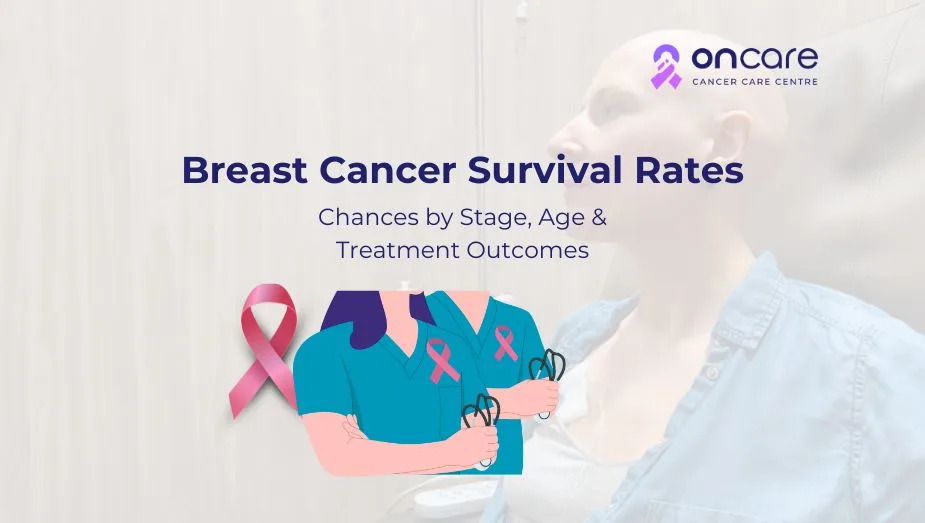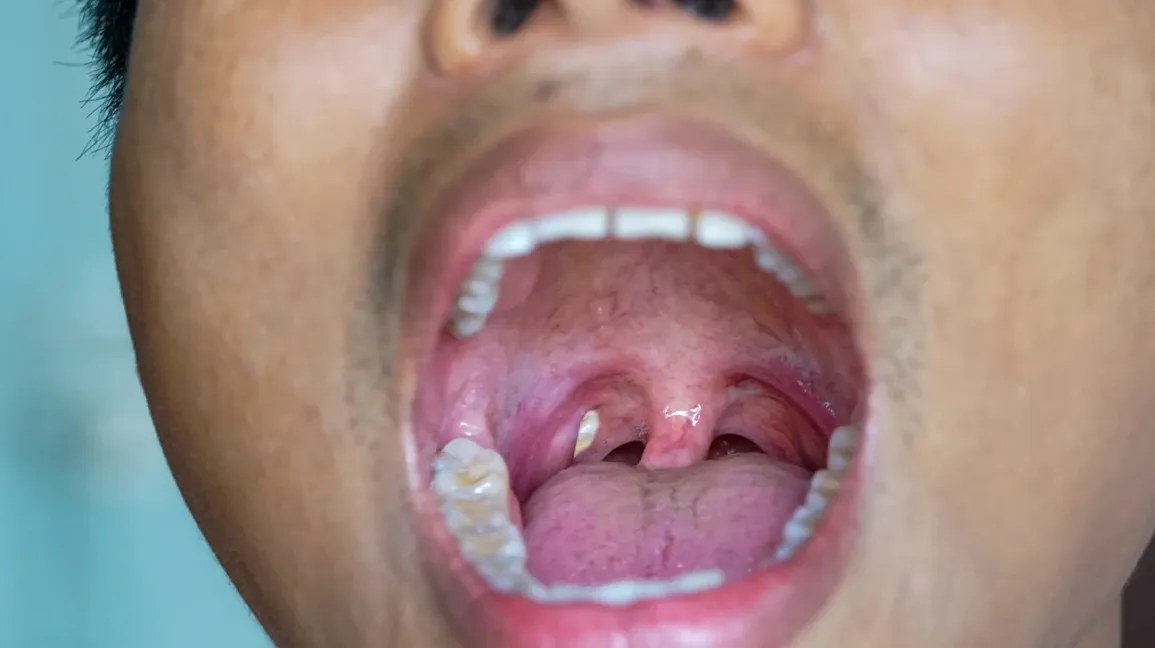Breast cancer is a universal disease and has become a leading health problem, especially for women. What is most concerning is how effective a treatment can be and what the chances of survival are if diagnosed with breast cancer. Through research and progress made in the field of breast cancer and its treatment, the mortality rate has decreased. At Oncare, our team of oncologists works together to give you a data-driven analysis of breast cancer and also provide best-suited treatment for it.
Now, to have a better understanding, let us dive deeper into this article. It will help you comprehend the overall aspect of breast cancer, types, stages, and factors that determine the survival rate of a person.

Content
Overview of Breast Cancer
Breast cancer develops in the breast cells when healthy cells undergo abnormal growth. Like any other cancer, it can grow out of control and sometimes spread to nearby tissues or other body parts. Women are more susceptible to having breast cancer, as about 1 in 8 are diagnosed with it every year. On the other hand, men have fewer chances of getting this disease. Therefore, proper prognosis and treatment are the sole weapons for battling breast cancer.
Breast Cancer Types
Before we go into checking the survival rate of breast cancer, let’s first learn about its types.
Invasive Lobular Carcinoma (ILC)
Most women in their lifetime can develop this type of breast cancer. There is a very high chance of females getting diagnosed with it. When cancerous cells start growing in the breast lobules, they invade the surrounding area. They start spreading further and take the form of a tumor, and are called Invasive Lobular Carcinoma. You can self-examine your breasts to feel if there are any lumps or pain in the area. This method may help you with early diagnosis if, by any chance, the lumps are cancerous.
Ductal Carcinoma In Situ (DCIS)
This type of breast cancer develops inside the milk ducts of the breast when abnormal cells grow in their tissue. Many women might have a fear of developing this type, or what will be the casualty. For your relief, this breast cancer is benign and highly curable as it does not spread to other tissues.
Invasive Ductal Carcinoma (IDC)
Sometimes, the abnormal cells spread to the surrounding parts of the tissue and expand their territory. This is known as invasive ductal carcinoma, which is another common cancer found in women.
Triple-Negative Breast Cancer
When the cancer cells do not have estrogen, progesterone, and human epidermal growth (HER-2) protein receptors, it is generally considered to be fatal or life-threatening. Also, the outcome of treatment is unpredictable or can be worse when not diagnosed early. Therefore, you can have an idea that the chances of a patient’s survival with this breast cancer are low. But as said earlier, you can always hope for better results by keeping your bodily changes in check.
Hence, knowing about the type of breast cancer can help you be cautious and observe any unusual lump growth in your breast and underarm area.
Survival Rate by Stages of Breast Cancer
As for breast cancer patients, many of them have questions regarding their chances of survival. Also, for women who are looking for breast cancer awareness, understanding the survival rate as per the stages can be very useful. Stages let you know where the cancer is in your body or how much it has developed.
Stage 0-1
This stage refers to the cancer that has not spread beyond the ducts of the breasts. It stays within the duct and does not go through the breast membrane. As it cannot invade the other tissues, the survival rate for patients is 99%.
Stage 2
Stage 2 refers to a tumor that has spread to the regional tissues or lymph nodes. Here, the tumor can grow up to 2 to 3 centimeters. For this breast cancer stage, the survival percentage can be 87% to 90%.
Stage 3
For stage 3 breast cancer, the number of affected lymph nodes keeps increasing. The tumor can grow up to 6 centimeters and can also invade the skin or the chest wall. If we look into the survival rate depending on the tumor biology, it is around 70% to 80.6% for this stage.
Stage 4
Coming to the most rigorous stage, the cancer has already taken the form of metastasis. It has outgrown the breast and lymph nodes and spread to other parts of the body. The survival rate for the same is lower compared to the other stages, as the percentage is 20 to 30%.
Average Survival Rate
Now, if you look at the stage-wise survival rate as explained above, you may be able to understand that the treatment and average survival of a person depend on the respective stage. However, these percentages are just an estimate and don’t mean that a patient will not survive. For breast cancer, a 5-year and 10-year timeline is followed by the oncologists to study the average longevity of a patient. The years help in calculating the average survival rate of those who were diagnosed with breast cancer 5 years or 10 years ago.
It is obvious to feel miserable when one gets diagnosed with breast cancer. But on a positive note, there have been various advancements made for treating different types and stages of breast cancer. Luckily, in most scenarios, patients have survived breast cancer and lived longer than their estimated survival years. Hence, early diagnosis can be a game-changer for a patient with breast cancer. It contributes to the treatment efficacy and chances of their survival. At Oncare, our advanced technology offers accurate diagnosis and reliable treatment for breast cancer at all stages.
Factors that Influence Survival Rates in Breast Cancer Patients
As you have learned about the average survival rate, understanding the influence of different aspects on it is important. Below are the factors to consider for surviving breast cancer.
Characteristic of Tumor
The size of the tumor, its grade, and its type play a key role in breast cancer survival. If a tumor is larger and of a higher grade in a patient, the prognosis is less favourable. Higher-grade tumors spread faster than lower-grade tumors. There is a high possibility that they will recur. Hormone Receptor status is also a prognostic factor of breast cancer and impacts the survival rate. ER, PR, and HER-2 are associated with long-term disease. If their levels are higher than average, the response to treatment will be low. Hence, locating and identifying the tumor, knowing its biology as early as possible, is crucial for improving the survival rate. Methods like mammography and breast ultrasound are effective for the proper diagnosis of tumor progression.
Genetic Factor
Genetic mutations can lower the survival rate of a patient. If someone in the family lineage had breast or ovarian cancer, their risk of developing it is increased. Therefore, through genetic testing, the treatment efficacy and survival of the person can be evaluated.
Treatment Accessibility
Data reveals that patients who could not survive breast cancer had either delayed their prognosis or did not follow up with the medical treatment. Timely intervention and medical assistance are important factors for survival. The improvements in breast cancer prognosis and treatment methods, like surgery, radiation therapy, chemotherapy, etc., have improved the survival rate of patients with breast cancer. Oncare is among the best healthcare clinics that use different approaches and procedures to provide comprehensive breast cancer treatment to patients who require immediate attention.
Age
The age of a patient is another important factor influencing the survival rate. Those who are older have fewer chances of survival than those who are younger. It is because, when you reach a certain age, your immune system and overall physical health are weakened. A woman diagnosed with breast cancer in her 50s will have a higher risk of mortality than those who are diagnosed with breast cancer while they are in their 20s may live longer.
Lifestyle
Leading a healthy lifestyle is as important as the treatment for breast cancer. Patients who follow a robust lifestyle and are physically active have a low mortality risk. What a person eats or drinks, how active or sedentary they are- it all gradually impacts the survival rate when diagnosed with breast cancer. As most oncologists state, drinking alcohol or smoking cigarettes can increase the risk of breast cancer. Hence, it is crucial to avoid any substances that are fatal to their health. Choosing a healthy lifestyle has always been favorable for battling any ailment. And it remains relevant for breast cancer, as the life expectancy of a person can be determined by their way of living.
Conclusion
Seeking an exact percentage of the survival rate of breast cancer can be confusing. The percentages can differ from the past few years, and the chances of survival in breast cancer patients could be higher. As frightening as the disease may seem, hoping for a positive outcome is important in battling against it. Your awareness and timely diagnosis can make it easier for oncologists to give better treatment. Therefore, if you want to take a step ahead for your well-being, reach out to our breast cancer specialist at Oncare. They will facilitate you with the best treatment opportunities and promising results. After all, your speedy recovery is our motto!
FAQs
Can breast cancer come back after treatment?
Yes, breast cancer can come back even after successful treatment. This is called recurrence and can happen locally, regionally, or in distant parts of the body. The odds vary, depending on variables like cancer type, stage at diagnosis, and treatment response. Life-long follow-up and monitoring remain vital for early detection of recurrence, with better chances of controlling and surviving the condition.
What are the warning signs of breast cancer?
The warning signs of breast cancer are very apparent. There are symptoms such as a lump in the breast or armpit, nipple discharge, change in breast size or shape, skin dimpling, or red or scaly skin on the breast. Some patients also exhibit pleuritic breast pain. Early recognition of these symptoms can be a sign of consultation that may enable earlier diagnosis, early detection, and improved survival.
How is breast cancer diagnosed?
Breast cancer is diagnosed based on a variety of options, from imaging tests, like mammography and ultrasound, to physical exams and biopsy procedures where tissue is tested for cancerous cells. Additional tests can also be required, like an MRI or a hormone receptor test. Diagnosis at an early stage is essential to initiate the treatment early (which has a profound bearing on survival and, ultimately, the long-term outcome).
What is the rate of survival after getting diagnosed with breast cancer?
Survival rates in breast cancer depend on the stage and your overall health. The 5-year relative survival for local disease is nearly 99%. If it extends to regional spread, it falls to approximately 86%, and distant metastases are associated with a survival of about 30% or less. These numbers are just estimates; lots of breast cancer patients have lived even longer, particularly with early diagnosis and advanced treatment approaches.
Does psychological and emotional support affect survival outcomes in breast cancer patients?
Yes, psychological support can enhance breast cancer survival. Support groups, counseling, and family participation have been shown to decrease stress and improve mental health, which in turn can increase patient response to the treatment and immune function. Research demonstrates that patients who receive emotional support are more likely to adhere to treatments and healthier lifestyles, ultimately having better-reported outcomes, which impact their survival rates.

Helen Bradley is a health blogger and the founder of her own blog about fitness. She has been blogging for three years now and loves to share what she learns with others. Helen enjoys reading, cooking, and staying active outdoors.











